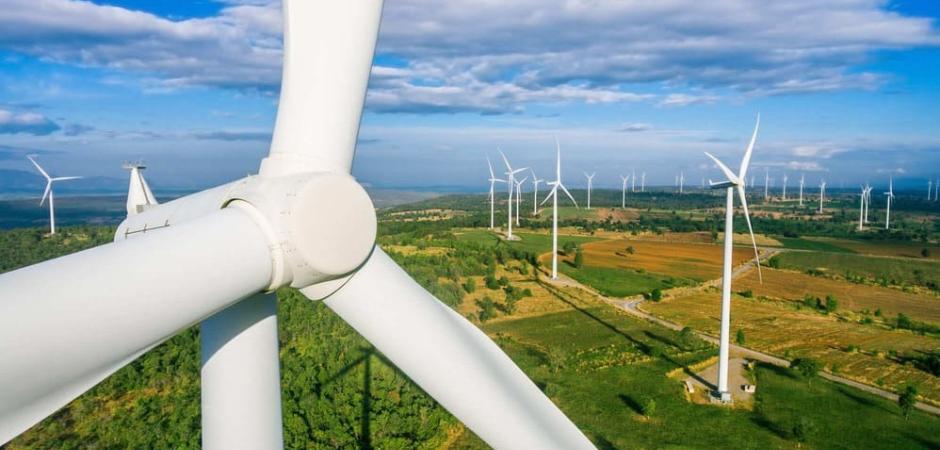
One of the markets we work for and with the greatest potential for growth and development is that of renewable energy. Innovation is a constant in this key sector, stemming from the search for new functional and effective solutions that are also more efficient and sustainable at both environmental and economic levels.
Against that backdrop of technological innovation, we have developed an extensive range of cables aimed at meeting various needs within the industry. Some offer specific characteristics that make them ideal for two of the most important sub-sectors of the renewable energy industry: wind and photovoltaic power.
According to the figures presented in Enerdata, wind and solar power accounted for 12,2% of all global power generated in 2022. With 34,8% and 33,2%, respectively, Portugal and Spain stood as global benchmarks. In fact, in late 2023 (on 2 November, to be precise), Spain broke an all-time record in renewable energy production for a single day thanks to wind power accounting for 73,3% of all the power produced, according to data from the Spanish Power Grid.
In order for this upward trend to be maintained in a stable and effective way, every component of the wind power industry must play its part. Our cables for the wind power industry are available in several different versions, mainly aimed at the operation of wind turbines and meeting specific needs in this sector.
Cables for the wind power industry: main characteristics
The cables used in the renewable energy industry need to be highly flexible, as well as easy to lay and install. It should be remembered that these cables are most often found in direct contact with the outdoors or forming part of equipment that interact with the natural elements, such as the wind, water or sunlight. As a result, both their installation and characteristics not only have to suit the role they perform as part of an electricity system but they also need to be able to withstand those elements and perform those same roles regardless of the climate or geographic circumstances that impact their location.
In the wind power industry, for example, the power of the wind creates kinetic energy that moves the blades on wind turbines. That motion in turn generates mechanical energy, which is the sum of the kinetic energy and the potential energy. The generator in a wind turbine transforms that mechanical energy into electricity. A wind turbine has three main parts: the rotor (made up by the three blades and the bushing); the multiplier in the motor, which increases rotation speed to raise revolutions per minute; and the generator, which converts the mechanical energy produced by the rotation into electricity. The cables for wind turbines are used to supply power but also to transmit data, signals or communication messages, as well as to control the entire system. The main distinction is made between cables for wind turbine motors and cables for instrumentation and control.
These cables often need to fit into very small spaces and guarantee correct function in the face of such highly demanding circumstances as exposure to temperatures between -40°C and +90°C or contact with vibrations and the continuous torsional movement produced by operation of the turbine itself, which can be up to 150°/m.
Wind power production facilities therefore need cables capable of performing various specific roles. However, all of them need to share these main characteristics:
- Flexibility and good torsional capacity, capable of withstanding both torsion and traction tension.
- Strong resistance to changing atmospheric conditions to prevent damage or premature ageing. They must be able to withstand extreme temperature ranges and attack from such factors as salt spray and sand.
- Excellent seals to prevent the ingress of water or other corrosive liquids.
- High levels of safety, such as being flame retardant and fire resistant.
Cables for the wind power industry from Sumcab
The cables we mainly recommend for wind turbines in the wind power industry include two product lines that offer excellent performance in terms of two of the most highly necessary requirements for this specific use: flexibility and resistance to high temperatures.
The cables in the Sumflex® series are flexibles cables especially suited to power supply and the control of fixed or mobile electrical installations and equipment either indoors or out. They offer flexibility and great strength, making them ideal for wind power generation towers among many other applications. For wind turbine instrumentation and control, we have the Sumflex® Ventus for fixed installation, consisting of a flexible polished copper conductor covered in special PVC capable of withstanding operating temperatures of between -40°C and +70°C. The Sumflex® Ventus TS and Sumflex® Ventus TS M-Line are especially suited to torsion applications (Loop), offering a maximum torsion capacity of some 150º/metre.
Within this series, we also have the Sumflex® Tray Cable 600V and Sumflex® Tray Cable CY 600V, both with UL and CSA, TC-ER (Tray Cable Exposed Run) certification to indicate the highest degree of crushing and impact resistance.
The Sumtherm® series includes a set of cables for high temperatures, which offer excellent thermal properties and are suitable for operation in extreme temperature atmospheres. For wind turbine motors, we have the Sumtherm® SIL-KUL models with service voltages of between 1.1kV and 13.8kV: Sumtherm® SIL-KUL 1.1kV, Sumtherm® SIL-KUL 3.7kV, Sumtherm® SIL-KUL 6.6kV and Sumtherm® SIL-KUL13.8kV. These are extra flexible cables made from varnished polyurethane fibre braid covered in special silicon that is highly resistant to the corona effect; they offer excellent resistance to oils and UV rays and can withstand operating temperatures in fixed and protected installation of between -55°C and +180°C.
These are just some of the cables recommended for use in wind power turbines but we always recommend contacting Sumcab for personalised advice on finding the most suitable solution to meet the specific needs of your equipment.

